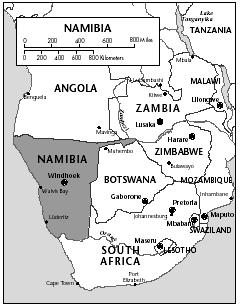Namibia - Personal background
Sam Shafishuna Nujoma was born on 12 May 1929 in Etunda Village in the remote northern region of Namibia known as Ovamboland. His origins are humble. He is said to have spent his early years herding goats at his family's homestead. Like many black Namibians, he received little

formal education. Though he did not complete high school, he boasts that he enabled many in SWAPO to further their education over the years while he stayed behind to do necessary political work. Little is known of his early life because, like Nelson Mandela, he was a "banned person" under South Africa's restrictive security legislation. For many years it was illegal either to quote Nujoma or to print his picture inside Namibia. As early as 1957, he was fired from a job on the South African Railways for attempts to organize a trade union. In 1959, he joined the Ovamboland Peoples Organization (OPO) while in Cape Town, South Africa. The OPO consisted of a group of Ovambo workers who gathered to discuss their grievances with the contract labor system. The early meetings of this group took place in a barbershop in Cape Town that is now part of Namibia's folklore.
After his termination from the railways, he returned to Windhoek, the capital of Namibia, where he became a leading figure in the protest against the removal of the Old Location, or ghetto, to its present site. South African authorities wanted to move the entire African section of Windhoek to this new location in order to place as much distance as possible between whites and non-whites. For blacks dependent on jobs in the city, the move was considered a severe hardship because it would add many commuting hours to the workday. The Africans called the new ghetto Katatura, which means "a place where we do not stay" in a local language. Demonstrations against this removal led to a bloody confrontation in December 1959 between police and demonstrators during which 13 unarmed civilians were shot and killed. Shortly afterward, Nujoma was detained for his role in the demonstration.
On his release, he fled the country. While visiting the UN in April 1960, Nujoma joined with other Namibian exiles to help reform OPO into SWAPO. He was chosen president of the new group and returned to Dar es Salaam, Tanzania, to build the organization of the party. His position was ratified by a party congress in 1963. He traveled the world in order to obtain international support both for SWAPO and for Namibian independence. In this effort, he met with considerable success; SWAPO was granted Observer Status at the UN, admitted as a member of the Organization of African Unity (OAU), and allowed to establish diplomatic missions in many countries around the world.
In 1966, SWAPO began a guerilla war against the South African government. Often described as a low-intensity conflict, this war lasted 23 years. By the war's end the military wing of SWAPO had approximately 10,000 troops including armored units. South Africa committed large numbers of troops and spent millions of dollars in scarce foreign currency on the conflict. Much of the northern part of Namibia was turned into a war zone, with thousands of soldiers and civilians killed. SWAPO also maintained a system of refugee camps in Angola and Zambia for Namibians fleeing political persecution and apartheid. It is estimated that over 60,000 people were cared for in these camps.
Beginning in 1977, Nujoma led a SWAPO team in negotiations with South Africa, the Frontline States, and the Western Five (the five permanent members of the UN). The result of these negotiations was Resolution 435, which set an outline for Namibian independence. The resolution was put into effect in 1989, when a UN-assisted ceasefire agreement was implemented.
Nujoma married Kovamba Katjimune in 1956. They have four children.
Comment about this article, ask questions, or add new information about this topic: